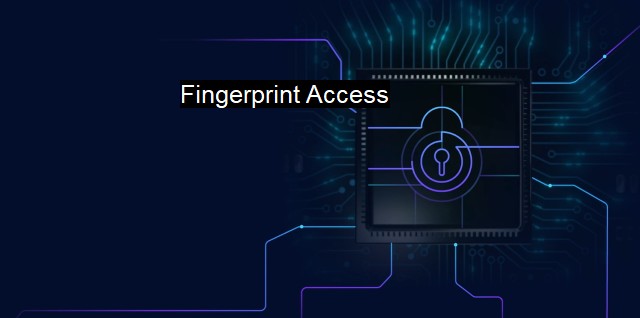What are Fingerprint Access?
The Rising Significance of Fingerprint Access in Cybersecurity: A Reliable Alternative to Traditional Authentication
Fingerprint access, within the context of cybersecurity and antivirus protection, refers to an authentication mechanism that employs biometric technology to verify the identity of an individual. Derived from the fact that every individual has unique fingerprints, which stay virtually constant throughout one's lifetime, fingerprint access serves both as a sophisticated, and vital tool in the cybersecurity sphere.Core to this mechanism is a fingerprint scanner that captures a digital image of the fingerprint, often through capacitive or optical means. Via its image processing software, it scrutinizes the unique ridges and valleys that constitute the layout of the finger, compounds these plus all the variant patterns into a unique identifier number and after this step then compares this against a store of predetermined values corresponding to authorised users. Beyond recognition, the system thereafter either declines or permits access depending upon the authenticity of the input compared to the stored fingerprints.
Fingerprint access, hence, offers numerous benefits in terms of cybersecurity and antivirus protocols. Primarily, it guarantees a unique user identification, rendering it nearly impossible for nefarious individuals to obtain unauthorized access. The need for users to memorize complex passwords or carry security tokens is eliminated since now, their fingerprint automatically becomes the password.
This leads to a major advantage of fingerprint access, which is immunity to phishing and hacking incidents. Known as the trump card of cybersecurity, fingerprint access ensures people cannot be tricked into revealing their fingerprints through deceptive emails or websites, implying an absolute end to conventional hacking measures—e.g., password cracking.
Contrarily, even when the fingerprints do happen to be replicated or forged- through artificial zealots or stimulations like biometric gloves- safeguards exist to counteract such intricate attacks. Fingerprint scanners can adopt pulse or body temperature sensors to differentiate between real fingers and fake replicas.
Regarding the antivirus aspects, fingerprint recognition constitutes an artwork against malware attempting unauthorized access. By associating device access with physical biometric characteristics, unidentified and potentially malicious users are barred from breaching systems and implanting viruses or executing programmed attacks.
It’s also pertinent to acknowledge the privacy issues and potential breaches that could happen with fingerprint access. Fingerprint records, if stored obliviously, can be prone to theft, giving hackers unauthorized access. So, while this mechanism facilitates strong security, it should be used with caution, and robust data protection measures must be used to secure the biometric data. Safety measures like two-factor authentication where fingerprint access is twinned with another security procedure could also be used to increase the trust level of biometric authentication techniques.
Implementation of fingerprint access is becoming more commonplace due to its convenience, reliability, and security features. Not just in smartphones or computer systems, technological leaps in biometric security are witnessing their usage in diverse areas like banks, immigration services, and even surveillance systems thereby building tech ecosystems with enhanced authentication measures and security protocols.
Fingerprint access in the context of cybersecurity and antivirus protection marks an era of state-of-the-art security measures that are steadily substituting traditional methods. By associating user access with unique physical characteristics like fingerprints, cybersecurity firms can create a stronger and safer system for the users. potential misuse and personal privacy are viable considerations that need to be balanced against the benefits offered and require perfect solutions as cyber threats continue to one-up security systems continuously. Hence, it deems the cornerstone for future advances and targets widespread application in systems for regulating unauthorized access and repelling malware threats.

Fingerprint Access FAQs
What is fingerprint access in cybersecurity?
Fingerprint access is a type of biometric authentication technology that uses a person's unique fingerprint to grant or deny access to devices, applications, or sensitive data. It is a more secure and convenient authentication method than traditional passwords or PINs.How secure is fingerprint access in antivirus software?
Fingerprint access is a highly secure authentication method because it is nearly impossible to duplicate or forge someone's fingerprint. However, it is important to ensure that the antivirus software implementing fingerprint access has proper security measures in place to prevent unauthorized access or hacks.Can fingerprint access be bypassed?
While it is difficult to replicate someone's fingerprint, it is not impossible. Hackers may use advanced techniques to bypass fingerprint authentication, such as taking a high-resolution photo of the person's fingerprint or using artificial replicas. It is essential to use strong encryption and other security measures to prevent such attacks.Is fingerprint access better than traditional password authentication?
Fingerprint access is a better authentication method than traditional passwords because fingerprints cannot be forgotten or easily stolen. Moreover, it is more convenient and user-friendly compared to remembering complex passwords. However, it is advisable to use multi-factor authentication, including fingerprint access, for additional security.| | A | | | B | | | C | | | D | | | E | | | F | | | G | | | H | | | I | | | J | | | K | | | L | | | M | |
| | N | | | O | | | P | | | Q | | | R | | | S | | | T | | | U | | | V | | | W | | | X | | | Y | | | Z | |
| | 1 | | | 2 | | | 3 | | | 4 | | | 7 | | | 8 | | |||||||